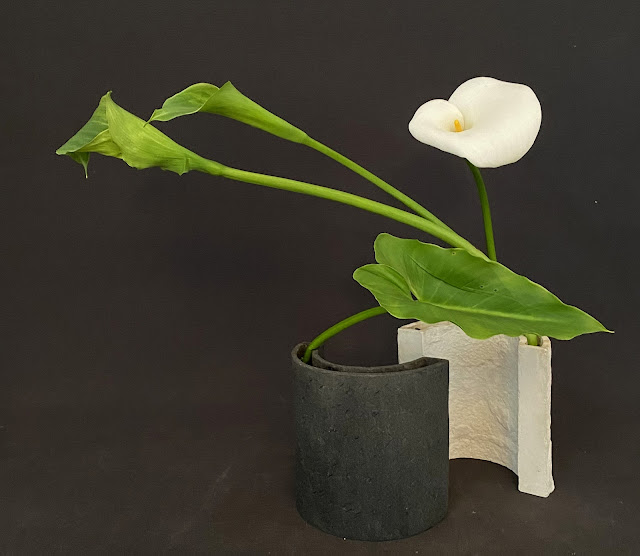Hello all,
Every year, around this time, I like to celebrate the arrival of spring with a large arrangement of spring blossoms. In this case I used prunus elvins, Japanese flowering quince and arum lilies.
I have so many plants in my garden, which were given to me by friends or relatives and which I treasure. One such shrub is the red rhododendron, from which I cut the branches, below, and which was given to us by my parents when we first moved into the house. Sadly, dad has been gone for 24 years and mum, who is 94 is suffering from dementia and has no memory of anything. These gorgeous blooms remind me of better times.
In last week's blog I posted photographs of the class arrangements using wattle. Unfortunately, my acacia aphylla had not flowered at that time. But it has now and I had to use it. My frilly daffodils, conveniently, flowered at the same time.
I dedicate this next arrangement to my colleague, Swann Lam, who arrived at my doorstep on a day of bucketing rain to hand me three, cymbidium orchid stems. It's been my experience that the thinner stemmed of these orchids need some support to prevent them from kinking downwards due to their weight. The dried, strelitzia reginae leaf has an interesting curl and worked well with both the container and the orchid.
It's been a week of pleasant surprises. Apart from Swann's orchids offering, I also received a number of containers and other ikebana paraphernalia. Hazel McNaught had been one of Norman Sparnon's students and in her later years, we became quite friendly. When she had to go into care, I used to visit her and take her out every once in a while. I was her only visitor because the only family she had left lived very far away.
When Hazell passed away, the family asked me to do the flowers at her funeral, which I considered an honour. Fast forward over 25 years and I get a phone call from Norm, the husband of Hazel's Niece, Elaine. She, too, had been an ikebanist and had collected containers, kenzans, etc. After losing Elaine, Norm wanted to give her ikebana 'treasures' to someone who would appreciate them. So, he very kindly, volunteered to bring them to me. Below is my first arrangement in one of Elaine's containers. The pussy willow was also a gift from my student, Nicole and the nandina berries at the back came from Dianne at last class.
When Mary arrived to class last week I sent her out with a cutter and carte blanche to cut whichever branch she wanted from the prunus elvins and whatever other materials she wanted from the garden. The branch she chose required quite a lot of trimming to reveal a sweeping line and, then, she followed that line with the arum lilies.
Mary was quite quick with her first arrangement and was able to do a second. So, out into the garden, once more and she produced the arrangement, below.
I was invited together with John Meade to an event at McClelland Sculpture Park and Gallery. The event is explained below:
A celebration of public art
This year marks
the half-way point of the 25-year public/private partnership program
which sees a series of contemporary sculptures installed along the Peninsula
Link freeway, near McClelland.
With 7 sculptures installed to date,
come celebrate with a special sculpture tour, drinks on Harry’s deck,
and a ceremonial lighting of Love Flower, by John Meade with Emily
Karanikolopoulos, to honour the occasion
 |
| John and me with our baby |
John and I were very pleased with the location in which the 'Love Flower' was installed. It has great visibility, especially from the cafe and is enhanced by the trees in the background. Also, it was great to see the plaque with our names on it.
The camellia stem in this next arrangement had such an ideal shape and the flower looking upwards, that all I had to do was find a container for it. Well, actually, I did have to remove some leaves and secure it in the container without the use of a kenzan.
Bye for now,
Emily















































